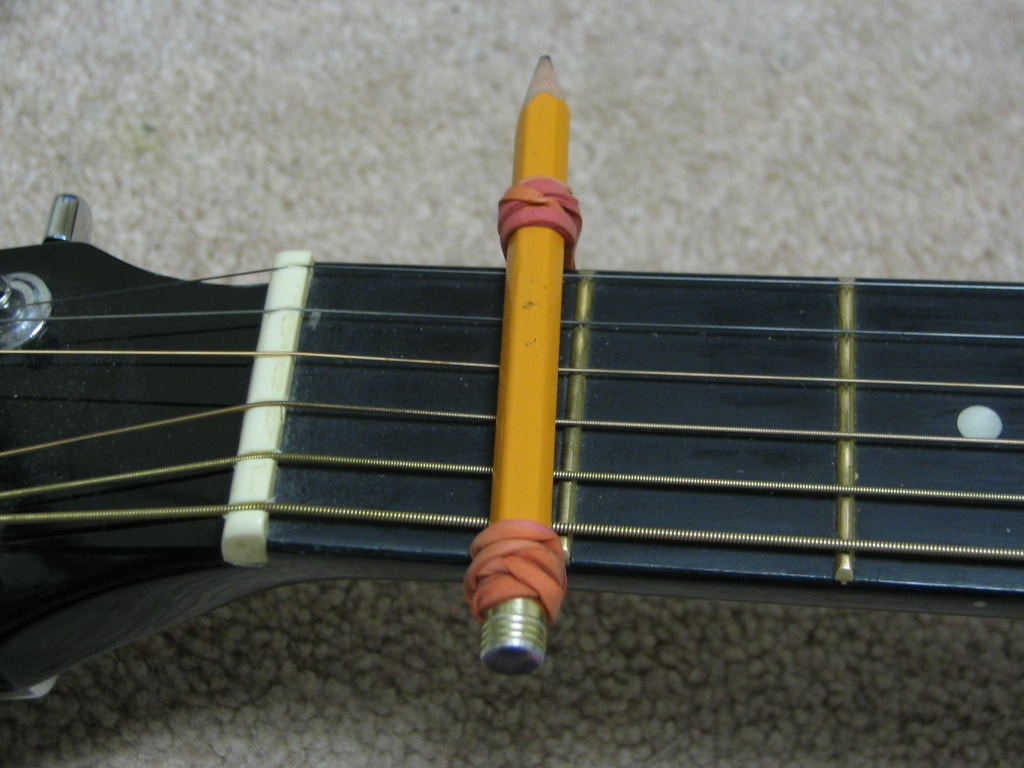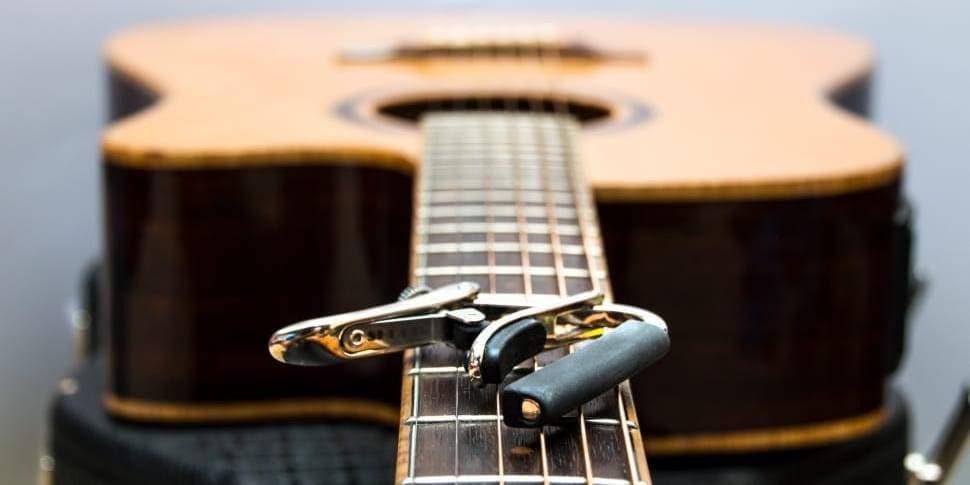Are you looking to try out a capo to see if you like it without spending $10 on a real capo? Or did your capo break, and you need to replace it quickly?
We’ve got you covered. If all you need is that capo functionality in a pinch, this simple method will have you up and running in minutes, and all you need is some rubber bands and a pen or pencil.
Contents
Homemade capo overview
If you want to skip to the end – here’s what you’re going to end up with. You just want to attach a pen or pencil to your fretboard with rubber bands, and you’re good to go.

For those who want additional instructions, let’s walk through this!
What is a capo and why might you need one – the Capo FAQ!
If you’re new to the guitar, you might have never heard of a capo. Or you may vaguely know what they are, but you don’t see the need for them.
Well let’s walk through some typical capo questions.
What is a capo?
A capo is a small device that clamps onto the neck of a guitar, and holds down the strings of one fret so that all the open strings are now that many frets higher.
For example, if you attach a capo on the third or G fret, your open strings are now G-C-F-A#-D-G, and playing a regular E chord will give you a G, and A will give you a C and so forth.
What is a capo for?
A capo allows you to play the same open chords you’re used to playing (E / G / A / C and D) but have them play higher notes, as the capo has now made the open strings play higher notes.
The advantage of this is that you can, on the fly, adjust for a singer who has a higher register.
Another reason would be that maybe a song just sounds way better all the way up in A instead of in E, but transposing the chords messes up the melody.
Some people use them at the 12th fret to get a tenor guitar song.
Really, there are a ton of uses for capos, more than we could go into here.
Is a capo necessary?
Depending on what you need to do, yes they can for sure be necessary. If you’re covering a song where a capo was used, you absolutely need one. If your singer suddenly wants to switch a song to a higher key, they save you transposing or losing the sound of open chords. If you’re jamming with a keyboard player and they need a song to be up one or two steps, a capo is a lifesaver.
Should a beginner use a capo?
A capo is a great tool for beginners as it allows you to play a ton of songs that are written with a capo, such as Here Comes The Sun by The Beatles. They’re also a ton of fun and allow you to do a lot of really creative things by placing them in different spots. You can also break yourself out of a rut by trying your new song in a different key without having to work out a bunch of new chords.
Is a capo cheating?
Not only is a capo NOT cheating, it’s actually something of an advanced method of playing the guitar. Some of the biggest professionals in the world use capos, from The Beatles, Rolling Stones and Bruce Springsteen, to Ed Sheeran and John Mayer. Most everyone with an acoustic guitar travels to a gig with a capo because they never know when they’ll need them.
HomeMade Capo Materials
To make your own capo at home, all you need are the following simple materials.
A Pen or pencil
The trick here is you want something that’s super straight and solid. If it’s curved, you’re going to end up with buzzing on the strings as it’s not pressing them down hard enough. If the pen or pencil has any give in it, it’s going to curve in the middle, and then you’re back to the first problem.
Rubber Bands
With the rubber bands, you want to make sure they’re long enough that you can stretch them out over your pen or pencil a couple of times. If you use a really short rubber band, you’re not going to be able to get the pen or pencil good and tight on the fretboard, and you’ll end up with buzzing when playing open strings.
Steps for making a DIY Capo
Making a capo is easy – but many forget the first step!
1: Tune your guitar
So many people forget this! Before you ever put your capo on you want to tune your guitar. It’s going to be a little harder to tune once the capo is on, so step one is to make sure you’re in tune and ready to go!
2: Lay the pen or pencil over the desired fret.
Moving the capo once it’s all set up is going to be a little tricky, so pick which fret you want it on. If you’re just experimenting, I would place the pen or pencil over the 5th fret as it’s the easiest to transpose notes. For example your E chord is now an A, your G is now a C, your A is now a D and so forth. Nothing too complicated.
3: Fold your rubber band in half, loop it over one end of the pen or pencil, and then loop it over the other end.
A lot of people just kinda throw the band on the end, but this can make it rub off your strings. Really what you want to do is make a loop with the rubber band on the pen or pencil, twist it once, then stretch it over the other side and loop again. Do this until your rubber band is good and tight.
4: Listen out for buzzing, and add more rubber bands until there is none.
You may find that one rubber band doesn’t make the pen or pencil press down hard enough on the strings to eliminate buzzing. No worries! Just add more until you get a good solid sound from the open strings without any buzzing.
And then you’re ready to go!
Need some visuals? Check out this awesome video.
How To Make a Capo Without Rubber Bands
So you’re in a pinch AND you have no rubber bands. The good news is you can substitute the bands for something like a piece of string or a shoelace and get your capo up and running in no time!
I’ve even seen some people use a highlighter instead of a pen and some rope instead of elastic bands.
Someone also said chopsticks and a McDonald’s straw….
I don’t know that you’re going to avoid fret buzz as much with these as you would with rubber bands and a pencil, but… Needs must!
Songs that use a capo
Here’s a quick list of some songs you might have fun playing with using your new DIY capo!
1st Fret
- “All Of Me” by John Legend
- “Friday I’m In Love” by The Cure
- “Mr. Brightside” by The Killers
- “Pride (In The Name Of Love)” by U2
- “Today” by Smashing Pumpkins
2nd Fret
- “Babel” by Mumford and Sons
- “Crooked Teeth” by Death Cab For Cutie
- “Fast Car” by Tracy Chapman
- “Photograph” by Ed Sheeran
- “Wonderwall” by Oasis
3rd Fret
- “Better Together” by Jack Johnson
- “Fix You” by Coldplay
- “No Surprises” by Radiohead
- “Say It Ain’t So” by Weezer
- “You And I” by Wilco
4th Fret
- “Bigmouth Strikes Again” by The Smiths
- “Groove Is In The Heart” by Deee-Lite
- “Hey Soul Sister” by Train
- “Payphone” by Maroon 5
- “Walk On The Ocean” by Toad the Wet Sprocket
5th Fret
- “I Dreamed I Saw St. Augustine” by Bob Dylan
- “I Will Follow You Into the Dark” by Death Cab for Cutie
- “Jesus Etc” by Wilco
- “Leave Out All The Rest” by Linkin Park
- “Nothingman” by Pearl Jam


